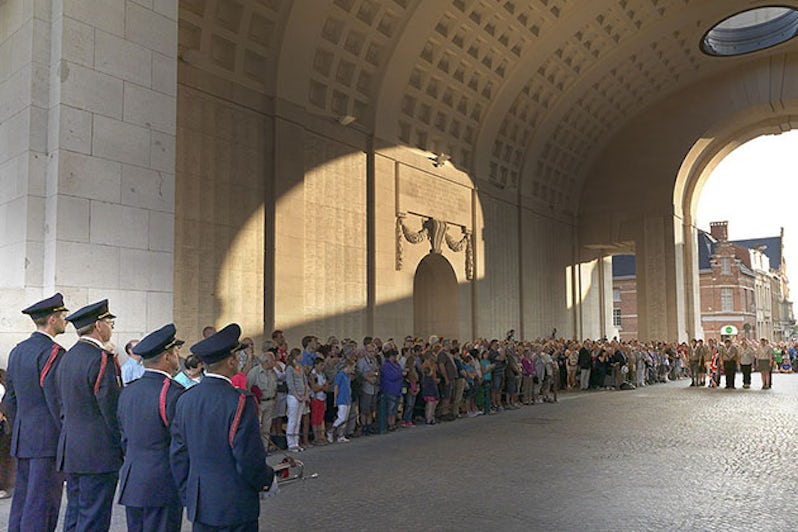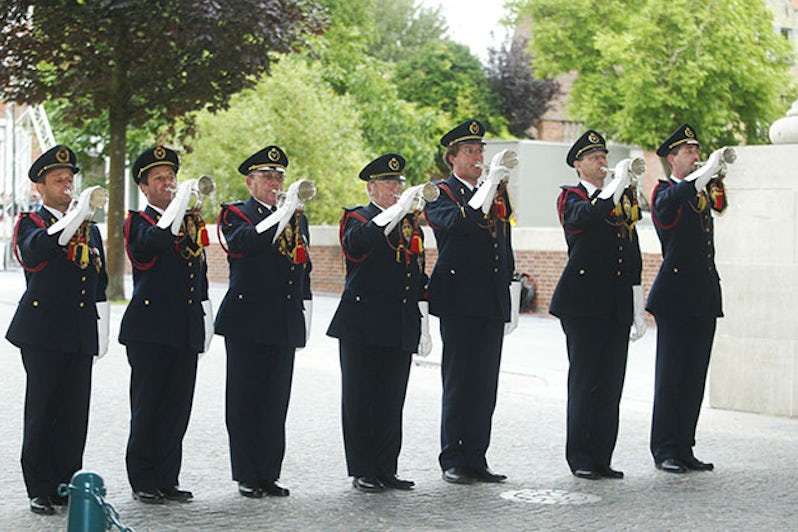Saga Pearl II's Ypres and the Last Post Excursion


The medieval Belgian town of Ypres (nowadays called by its Flemish name Leper) is synonymous with the devastating trench warfare of the First World War. It was in this area that major battles took place between 1914 and 1918, and today visitors will find wartime cemeteries, museums and memorials, such as the Menin Gate, dedicated to the British and Commonwealth soldiers who were killed in the war and whose graves are unknown. Saga is among the cruise lines offering excursions to Ypres and the surrounding region.
What It Is
Saga's Ypres and the Last Post tour is an optional afternoon and evening excursion available on itineraries that call at Zeebrugge. The package includes visits to the Memorial Museum Passchendaele 1917, the Tyne Cot Cemetery and Ypres, where there is free time before attending the Last Post Ceremony which has been held every evening at the Menin Gate since 1928.
Our Experience
We left after lunch for the one hour drive to Passchendaele. The local guide filled in the time with an informed talk about the battles fought around Ypres, and handed out a useful map showing the changing position of the semi-circular Front Line running from the northeast, east and southeast of Ypres during successive battles.
Our first stop was the museum that focuses on the Third Battle of Ypres, where the allies won just five miles of territory over 100 days at a cost of 500,000 casualties. Housed in an old chateau in what was once the heart of the battlefield, the atmospheric galleries are well laid out with tableaux showing soldiers in various uniforms, a film about the battle and numerous artefacts. I was particularly interested in the interactive elements, which include the chance to smell simulated mustard gas (nauseous) and battlefield rations (very unappetising), feel the weight of tin helmets and try (and mostly fail) to lift 61lb (27kg) kit bags.
There is a replica of a dug out in the museum cellar, accessed by steep stairs, showing where men lived like moles in dark, spartan living quarters with rudimentary cooking and medical facilities. Outside is an impressive reproduction of a network of trenches, built in 2013. It was an eerie and evocative experience to walk across the dry wooden duck boards, shaded by high earth walls, on a fine summer's day; even that brought home the horror of what it must have been like for soldiers dealing with a never-ending struggle against water and mud that turned the trenches into quagmires, then clambering up the uneven sides to "go over the top".
We spent an hour in the museum, although ideally you would need two or three hours to explore in depth. However, to keep to the itinerary we needed to move on to Ypres, five miles away.
On arrival there was free time to browse around the compact centre. Some members of the group stocked up on Belgian chocolate while others relaxed over a glass of the country's other famous product -- beer -- or had a snack in one of the many cafes lining the square. As evening fell people began walking towards the white Portland stone monument that is one of the most visited war memorials in Western Europe. Completed in 1927, the walls are inscribed with the names of 54,389 officers and men from UK and Commonwealth Forces who fell in the Ypres Salient and who have no known grave.
When we arrive a couple of hundred people of all ages have already gathered on the pavement, mostly standing in silence. At 7:30 p.m. the road passing beneath the Menin Gate is closed for the ceremony. The buglers, all local fire fighters, arrive at 7:55 p.m. and five minutes later the haunting sound of the Last Post broke the silence, the notes carried across the cobbled streets and towards the surrounding fields where hundreds of thousands lost their lives. The bugle call, traditionally played to mark the end of the day, has now come to represent a farewell to the fallen. As the bugles were lowered, groups of schoolchildren, scouts and other youth and adult organisations came forward to lay wreaths of poppies.

The buglers then played the Reveille, which summoned troops to their duties at the start of the day and now marks the end of this simple but incredibly moving ceremony.
We headed back to the bus for the transfer to the ship -- fortified by Werther's Originals, which are a trademark of Saga shore excursions and handed out by the crew member accompanying each tour.
Worth a Try?
Without a doubt. It is a very memorable, albeit emotional, experience; particularly for anyone who lost relatives during the First World War.
Things to Note
The seven and a half hour excursion costs £59 per person and includes transportation and entry fee to the 1917 Memorial Museum. Comfortable shoes are a must as the tour involves a lot of walking and standing. The Last Post Ceremony begins at 8 p.m., however people start gathering at the Menin Gate from 7 p.m. in order to get a good view and the spectators can be up to ten deep in the spring and summer. There is a reserved area for wheelchair users and the disabled. Visitors are requested to remain silent throughout the ceremony and not applaud during or afterwards. Passengers will have missed dinner in the restaurants by the time they return to Saga Pearl II at around 9:30 p.m., but can order room service.